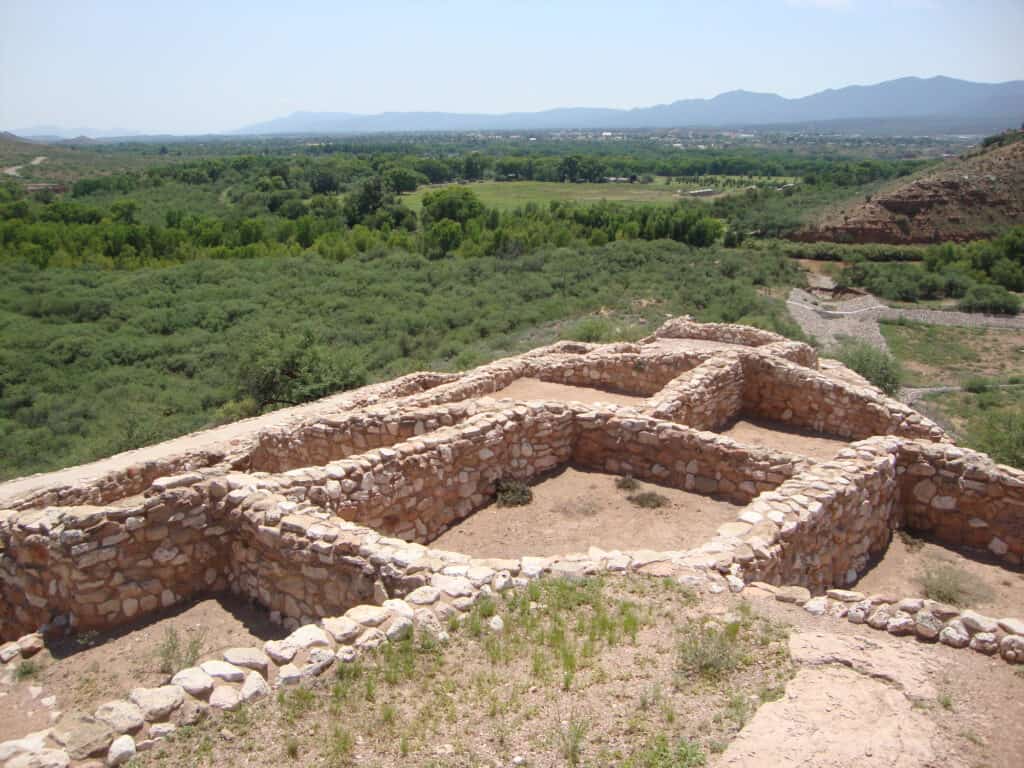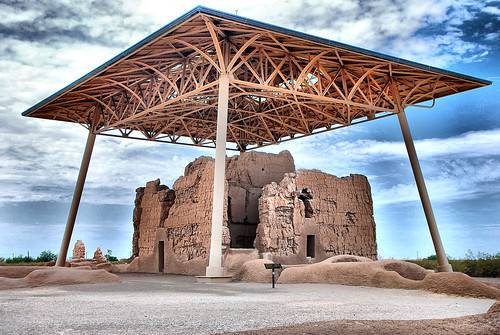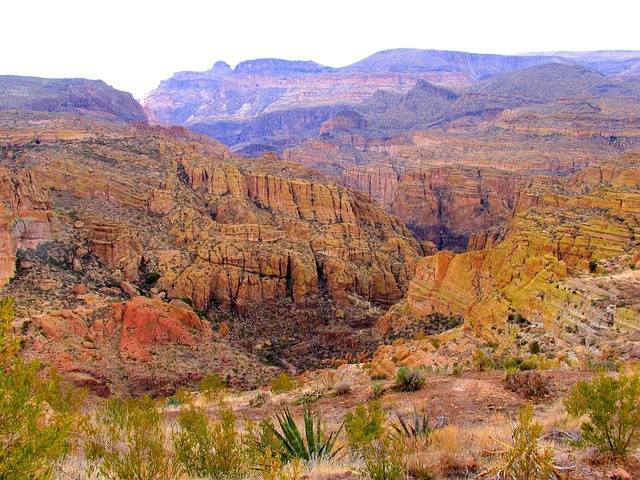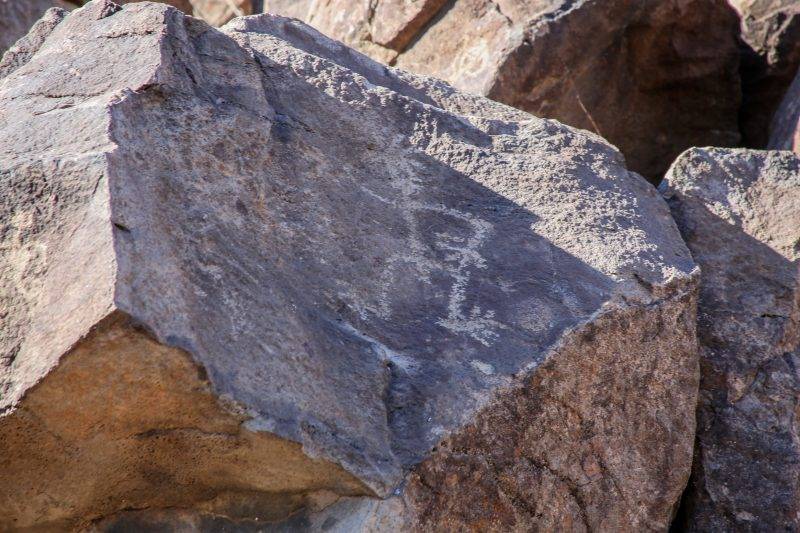Native American ruins around Arizona – The Most Famous Indian Ruins in Arizona
15 Incredible Indian Ruins in Arizona
If you are planning a visit to Arizona, you should also plan a trip to visit the Indian Ruins in Arizona.
Arizona remains the state with the largest percentage of Native Americans in the United States and one quarter of the state is reservation land. This makes it an ideal place to learn more about the culture and visit the Indian ruins in Arizona.
Walnut Canyon National Monument
Walnut Canyon is, without doubt, one of the most fascinating wonders not just in Arizona but in the whole world.
While here, you’ll encounter cliff dwellings that show why the Sinagua people were experts in living without water. They built their homes deep within the canyon under the limestone ledges and utilized the small spaces both for cooking and sleeping.
As you walk within the Walnut Canyon, you can’t help but wonder how the ancient inhabitants survived in such a precarious environment.
Cutting through densely-wooded plateaus, the Walnut Canyon is easily reached from the city of Flagstaff, which is about two hours and fifteen minutes from Phoenix.
Admission $15
Canyon de Chelly National Monument
Canyon de Chelly is one of the most unique Indian ruins in the U.S. It preserves the remains of 5,000 years of Native America habitation.
Containing the rock art of indigenous people such as Ancestral Puebloans and Navajo that lived in the region for centuries, Canyon de Chelly is one of the most visited National Monuments in the country today.
It is also one of the longest constantly inhabited places in North America. The hunting petroglyphs on the rocks are a clear indication that the inhabitants utilized the canyons for hunting and seasonal gathering.
Located approximately 5 hours northwest of Phoenix in Chinle, Arizona
Free Admission
Montezuma Castle National Monument
The Montezuma Castle National Monument is a historical archaeological site located in the Verde River. Last used over 600 years ago by the Sinagua Indians, the Montezuma Castle is one of the best-preserved cliff dwellings in North America.
The castle, which is built 90 feet off the valley floor, is not connected to the Aztec emperor –Montezuma- whose name it carries.
Nestled into a limestone recess above the Beaver Creek, this castle is a breathtaking five-story 20-room cliff dwelling.
The Sinagua Indians used the Montezuma Castle not just as their home but also as a community center where they stored crops, held community meetings, and even buried their dead!
Montezuma Castle National Monument is a 90-minute long drive from Phoenix.
Admission is $15
Casa Grande Ruins National Monument
This is home to prehistoric ruins of various structures and compound walls that were constructed by the ancient Hohokam people.
Photo via @Flickr
Archaeological evidence shows that the ancestral Sonoran Desert people built the Casa Grande in the 13th century and were predominantly farmers who farmed in the Gila Valley.
While the structures were constructed using the traditional adobe processes (using dried mud brick), they were abandoned around 1450 after 1000 years of existence, but are still evident today.
Located about an hour-long drive from Phoenix, the Casa Grande Ruins National Monument is situated in Coolidge, Arizona.
Admission is $10
Pueblo Grande Museum
The Pueblo Grande Museum is an archaeological site of the Hohokam culture. Home to some of the largest and most advanced canals and irrigation systems in pre-Colombian North America, there is no doubt that this area was once home to a prosperous civilization known as Huhugam.
To put it into perspective, the native inhabitants of the Pueblo Grande were the first people to practice irrigation in the region.
Like many other historical villages in Arizona, these canals and irrigation systems are among the most fascinating things you’ll ever come across.
Located next to Sky Harbor International Airport just 15 minutes from downtown Phoenix.
Admission is $6
Tonto National Monument
The Tonto National Monument is one of the few Indian ruins that tell the captivating story of the Salado Indians.
Over 700 years ago, the Salado Indians borrowed cultures of their neighbors and blended them together to create a unique and vibrant culture known as the Salado phenomena.
The Salado people were predominantly farmers but their unique architecture and ability to build some of the best ancient cliff dwellings are unrivaled.
While it is not quite clear why the Salado people built these cliff dwellings, visiting Tonto National Monument will give you a once-in-a-lifetime opportunity to see what living up high in the hillside caves looked like.
Situated about 2 hours from Phoenix, Arizona near Roosevelt.
Admission $10
Sierra Ancha National Wilderness
Located within the Tonto Basin, 2 hours from Phoenix, Sierra Ancha National Wilderness is an enchanting and expansive wilderness that hides within itself, a deep history of the Salado Indians.
Forget about the precipitous box canyons, pine-covered mesas, and towering vertical cliffs, this area presents a mysterious history of the Salado Indians.
Inhabited somewhere between 1280 and 1350 AD, there are several Indian ruins that show three different Native Indian Traditions: Sinagua to the north, Hohokam to the west, and Mogollon to the east.
While there are a lot of cliff dwellings in Arizona, Sierra Ancha is arguably the most unique. Brace yourself; you’ll encounter cliff dwellings built in extremely inaccessible locations.
Tuzigoot National Monument
Tuzigoot, an Apache word for “crooked water” is a 3-story Pueblo ruin built atop a sandstone and limestone ridge.

Consisting of 110 stone masonry rooms, the Tuzigoot houses the remnants of a Sinagua Village that was built 120 feet above the Verde Valley more than 1,000 years ago.
It is believed that the Sinagua people who were farmers and hunters who built this village to escape drought. Visiting Tuzigoot is a worthy day trip that will provide you with good information on the daily lives of the ancient Sinagua people.
About 2 hours north of Phoenix is the Tuzigoot National Monument just near the Montezuma Castle National Monument.
Admission $15
Wupatki National Monument
Another Indian ruin located near the city of Flagstaff, the Wupatki National Monument is a landscape of legacies. This is a unique area that gives you a rare glimpse into the lives of the ancient Pueblo people.
Wupatki, which means “Tall House”, is a single building but is surrounded by many other ruins scattered in this enormous desert.
In an area where it seems almost impossible to find any source of water and food, ancient inhabitants made it possible against all these odds! They were able to farm, trade, raise families and thrive at the backdrop of Mother Nature’s hostility.
If you’re questioning how they did it, visit this immaculate place and listen to the whispers of this expansive land.
Situated about 2 hours 40 minutes-drive north of Phoenix, near Flagstaff, Arizona
Admission $25
Mesa Grande Cultural Park
The Mesa Grande clearly highlights the heights of Hohokam’s civilization in the Salt River Valley. The Hohokam constructed the Mesa Grande temple mound at around AD 1100 and lived in the area for about 300 years.
With walls made from calcium carbonate hardpan, these structures were extensive water canal systems that show the dramatic engineering skills of the ancient people.
The fact that these people could turn an arid landscape into an agricultural landscape is even beyond today’s imagination.
About 20 minutes from downtown Phoenix, in Mesa, Arizona
Admission $5
Navajo National Monument
The Navajo National Monument is a sight to behold! It is home to three prehistoric cliff dwellings: Keet Seel, Betatakin, and Inscription House.
These cliff dwellings were inhabited by the Kayenta Ancestral Pueblo who lived in this region somewhere between 1250 and 1300 CE.
The Kayenta people were originally hunters and gatherers but became farmers in order to make good use of the fertile bottom-land soils and the area’s perennial streams.
It’s widely believed that the dwellings were built to protect their harvests from rodents and also to defend inhabitants from their enemies.
Located about four and a half hours north of Phoenix, in Kayenta.
Admission $10
Agua Fria National Monument
The Agua Fria National Monument is an area of high elevation desert between the Sonoran cactus lands and the grass-chaparral belt. It is, without question, one of the most fundamental prehistoric sites in Arizona.
In addition to the historic Agua Fria River, there are several remains of the Pueblo communities that lived in the area. From the available petroglyphs, pottery, and other artifacts, it is believed that the Pueblo people lived here between 1250 and 1450 AD.
With over 750 prehistoric habitation structures scattered throughout the region, you’ll never lack some amazing information about Native Americans centuries before the Europeans arrived.
Situated 40 miles north of Phoenix.
Admission is free
Mindeleff Cavates Lodge Group
Named after visionary archaeologist Cosmos Mindeleff, the little known Mindeleff Cavates Lodge Group refers to a number of caves across the Verde River.
Located almost two and a half hours north of Phoenix, these are 89 separate man-made caves with a total of 343 rooms.
They are typically characterized by small openings in the cliff face with the main room being big enough for an adult to stand up in.
Although there are no artifacts to show the way of life in the prehistoric time, visiting the Mindeleff Cavates will offer you enchanting insights at how far modern civilization has come.
Roger’s Canyon Cave Ruin
Deep in the heart of Superstition Mountain some 48 miles east of Phoenix, is a magnificent canyon named the Roger’s Canyon. This canyon was home to the Salado Indians some 600 years ago.
This particular ruin is believed to have housed about 100 ancient people in its 65 rooms, some of which were used as stores.
Built into a series of minute caves, they have both lower and upper caves. These ruins are built in very rugged surroundings and will offer you visible memories that will stick with you for a very long time.
Fortaleza Indian Ruins
Loosely translating to a “Fort on a Hilltop”, Fortaleza is located approximately 40 miles southwest of Phoenix along the north bank of Gila River. Built and occupied by the Hohokam somewhere between 1200 and 1400 AD, this prehistoric site is one of the few Indian ruins in Arizona that was explicitly built for defensive purposes.
Although the site is today considered a crucial spiritual site of the Tohono O’odham Nation, it was a real fortress many centuries ago. The site was almost completely destroyed, perhaps as a result of numerous prehistoric conflicts in the area. However, it remains a colossal structure that clearly highlights how security was a top priority even for ancient Native Americans.
Sharing is Caring! Pin this article to save for later.
Continue Reading:
- What to do in Las Vegas your first time
- Arizona Slot Canyons you must visit
- Upper vs Lower Antelope Canyon – Which one is best?
- Best Hikes in Arizona
- Consider getting a National Park Pass
Recent Posts
Welcome to the enchanting world of Óbidos, a medieval gem nestled in the heart of Portugal. If you are wondering what to do in Obidos, you are in the right place. This list of best things to do in...
15 Best Things to do in Nazare: Guide to Portugal's Surf Paradise
Embracing Nazaré’s Coastal Charm Nestled along Portugal's Silver Coast, Nazaré is a picturesque fishing village that has recently soared in popularity, not just for its rich history but for...














